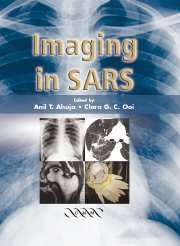Book contents
- Frontmatter
- Contents
- Contributors
- Preface
- 1 The Epidemiology of Severe Acute Respiratory Syndrome: A Global Perspective
- 2 The Role of Emergency Medicine in Screening SARS Patients
- 3 Severe Acute Respiratory Syndrome Outbreak in a University Hospital in Hong Kong
- 4 Imaging of Pneumonias
- 5 The Role of Chest Radiographs in the Diagnosis of SARS
- 6 Chest Radiography: Clinical Correlation and Its Role in the Management of Severe Acute Respiratory Syndrome
- 7 The Role of High-Resolution Computed Tomography in Diagnosis of SARS
- 8 The Role of Imaging in the Follow-up of SARS
- 9 Treatment of Severe Acute Respiratory Syndrome
- 10 SARS in the Intensive Care Unit
- 11 Imaging of Pneumonia in Children
- 12 Imaging and Clinical Management of Paediatric SARS
- 13 Imaging of SARS in North America
- 14 Radiographers' Perspective in the Outbreak of SARS
- 15 Implementation of Measures to Prevent the Spread of SARS in a Radiology Department
- 16 Aftermath of SARS
- 17 Update on Severe Acute Respiratory Syndrome
- Index
15 - Implementation of Measures to Prevent the Spread of SARS in a Radiology Department
Published online by Cambridge University Press: 27 October 2009
- Frontmatter
- Contents
- Contributors
- Preface
- 1 The Epidemiology of Severe Acute Respiratory Syndrome: A Global Perspective
- 2 The Role of Emergency Medicine in Screening SARS Patients
- 3 Severe Acute Respiratory Syndrome Outbreak in a University Hospital in Hong Kong
- 4 Imaging of Pneumonias
- 5 The Role of Chest Radiographs in the Diagnosis of SARS
- 6 Chest Radiography: Clinical Correlation and Its Role in the Management of Severe Acute Respiratory Syndrome
- 7 The Role of High-Resolution Computed Tomography in Diagnosis of SARS
- 8 The Role of Imaging in the Follow-up of SARS
- 9 Treatment of Severe Acute Respiratory Syndrome
- 10 SARS in the Intensive Care Unit
- 11 Imaging of Pneumonia in Children
- 12 Imaging and Clinical Management of Paediatric SARS
- 13 Imaging of SARS in North America
- 14 Radiographers' Perspective in the Outbreak of SARS
- 15 Implementation of Measures to Prevent the Spread of SARS in a Radiology Department
- 16 Aftermath of SARS
- 17 Update on Severe Acute Respiratory Syndrome
- Index
Summary
Introduction
Patients infected by severe acute respiratory syndrome (SARS) require imaging during the course of their disease. Plain radiography and computed tomography (CT) will be employed routinely, although during an epidemic all imaging modalities may be requested at some point. Infection control is concerned with protecting the individual against infection and containing an outbreak, at the same time as providing medical care for those patients with SARS. In a radiology department it is, of course, of utmost importance that the staff are protected, but for those centres that also have to maintain essential services for patients without SARS, there is the additional consideration of preventing cross infection between patients. When planning control measures against any infection, details of the mode of infection. Transmission must be taken into account, for the SARS coronavirus the important points to take into consideration are shown in Table 15.1. The format of this chapter may appear laborious, but it is designed to provide practical checklists covering some of the most important issues that need to be considered when preparing a department for the battle against infection.
Infection control measures to be taken by staff
Staff education
This is one of the most important aspects of infection control:
All staff must be fully aware of the infection control guidelines of the department and hospital, and should be trained in infection control measures before entering any high-risk area.
[…]
- Type
- Chapter
- Information
- Imaging in SARS , pp. 149 - 158Publisher: Cambridge University PressPrint publication year: 2004

